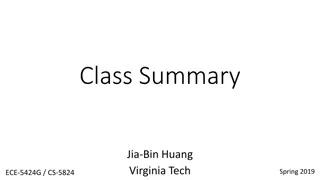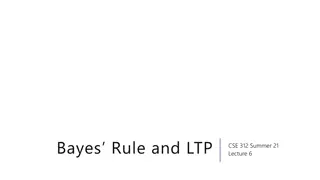Multivariate Analysis
Explore the key concepts of marginal, conditional, and joint probability in multivariate analysis, as well as the notion of independence and Bayes' Theorem. Learn how these probabilities relate to each other and the importance of handling differences in joint and marginal probabilities.
5 views • 43 slides
Understanding Conditional Probability and Bayes Theorem
Conditional probability relates the likelihood of an event to the occurrence of another event. Theorems such as the Multiplication Theorem and Bayes Theorem provide a framework to calculate probabilities based on prior information. Conditional probability is used to analyze scenarios like the relati
1 views • 5 slides
Understanding Bayesian Reasoning and Decision Making with Uncertainty
Exploring Bayesian reasoning principles such as Bayesian inference and Naïve Bayes algorithm in the context of uncertainty. The content covers the sources of uncertainty, decision-making strategies, and practical examples like predicting alarm events based on probabilities.
1 views • 32 slides
Understanding Bayesian Learning in Machine Learning
Bayesian learning is a powerful approach in machine learning that involves combining data likelihood with prior knowledge to make decisions. It includes Bayesian classification, where the posterior probability of an output class given input data is calculated using Bayes Rule. Understanding Bayesian
0 views • 17 slides
DoS Detection for IoT Networks Using Machine Learning: Study Overview
As the number of IoT devices grows rapidly, the need for securing these devices from cyber threats like DoS attacks becomes crucial. This study aims to evaluate the effectiveness of machine learning algorithms such as Gaussian Naive Bayes, K-Nearest Neighbors, Support Vector Machine, and Neural Netw
1 views • 13 slides
Understanding Naive Bayes Classifiers and Bayes Theorem
Naive Bayes classifiers, based on Bayes' rules, are simple classification methods that make the naive assumption of attribute independence. Despite this assumption, Bayesian methods can still be effective. Bayes theorem is utilized for classification by combining prior knowledge with observed data,
0 views • 16 slides
Understanding Probabilistic Retrieval Models and Ranking Principles
In CS 589 Fall 2020, topics covered include probabilistic retrieval models, probability ranking principles, and rescaling methods like IDF and pivoted length normalization. The lecture also delves into random variables, Bayes rules, and maximum likelihood estimation. Quiz questions explore document
0 views • 53 slides
Understanding Conditional Probability and Bayes Theorem
Conditional probability explores the likelihood of event A given event B, while Bayes Theorem provides a method to update the probability estimate of an event based on new information. Statistical concepts such as the multiplication rule, statistical independence, and the law of total probability ar
0 views • 15 slides
Machine Learning Algorithms and Models Overview
This class summary covers topics such as supervised learning, unsupervised learning, classification, clustering, regression, k-NN models, linear regression, Naive Bayes, logistic regression, and SVM formulations. The content provides insights into key concepts, algorithms, cost functions, learning a
0 views • 39 slides
Introduction to Bayesian Classifiers in Data Mining
Bayesian classifiers are a key technique in data mining for solving classification problems using probabilistic frameworks. This involves understanding conditional probability, Bayes' theorem, and applying these concepts to make predictions based on given data. The process involves estimating poster
0 views • 20 slides
Foundations of Probabilistic Models for Classification in Machine Learning
This content delves into the principles and applications of probabilistic models for binary classification problems, focusing on algorithms and machine learning concepts. It covers topics such as generative models, conditional probabilities, Gaussian distributions, and logistic functions in the cont
0 views • 32 slides
Campaign Manifesto: Theo Thomas for Head Boy Position
Theo Thomas presents his candidacy for the Head Boy position, highlighting his leadership experience and dedication to promoting equality and inclusion within the school community. He envisions implementing initiatives such as recognizing staff achievements, rewarding prefects and house leaders, and
0 views • 4 slides
Understanding Naive Bayes Classifier in Data Science
Naive Bayes classifier is a probabilistic framework used in data science for classification problems. It leverages Bayes' Theorem to model probabilistic relationships between attributes and class variables. The classifier is particularly useful in scenarios where the relationship between attributes
1 views • 28 slides
Igniting a Passion for Change: Arsonist or Mere Accelerant?
George W. Cobb, from Mount Holyoke College, explores the concept of igniting passion for change and questions whether the catalyst for change is akin to an arsonist or merely an accelerant. The presentation delves into the role of computation, simulation, Fisher's vision in statistical analysis, and
0 views • 20 slides
Movie Script Shot Lister Tool Development Project
This project aims to create a tool, the Lister Tool, that takes properly formatted motion picture scripts as input and generates a shot list for the movie using Training Sets and Naive Bayes. The project involves several components such as the Parser, Liner Tool, Training Sets, and more. The ultimat
2 views • 42 slides
Understanding Basic Classification Algorithms in Machine Learning
Learn about basic classification algorithms in machine learning and how they are used to build models for predicting new data. Explore classifiers like ZeroR, OneR, and Naive Bayes, along with practical examples and applications of the ZeroR algorithm. Understand the concepts of supervised learning
0 views • 38 slides
Text Classification and Naive Bayes in Action
In this content, Dan Jurafsky discusses various aspects of text classification and the application of Naive Bayes method. The tasks include spam detection, authorship identification, sentiment analysis, and more. Classification methods like hand-coded rules and supervised machine learning are explor
1 views • 82 slides
Understanding Text Classification Using Naive Bayes & Federalist Papers Authorship
Dive into the world of text classification, from spam detection to authorship identification, with a focus on Naive Bayes algorithm. Explore how Mosteller and Wallace used Bayesian methods to determine the authors of the Federalist Papers. Discover the gender and sentiment analysis aspects of text c
0 views • 71 slides
Bayesian Classification and Intelligent Information Retrieval
Bayesian classification involves methods based on probability theory, with Bayes' theorem playing a critical role in probabilistic learning and categorization. It utilizes prior and posterior probability distributions to determine category given a description. Intelligent Information Retrieval compl
0 views • 19 slides
Understanding Bayes Theorem in NLP: Examples and Applications
Introduction to Bayes Theorem in Natural Language Processing (NLP) with detailed examples and applications. Explains how Bayes Theorem is used to calculate probabilities in diagnostic tests and to analyze various scenarios such as disease prediction and feature identification. Covers the concept of
0 views • 13 slides
St. Thomas of Aquin's High School Overview
St. Thomas of Aquin's High School is a welcoming and inclusive school community that prioritizes meeting the diverse needs of all students. With a strong focus on values such as self-discipline, teamwork, and mutual respect, the school aims to create a safe and supportive environment for students to
0 views • 14 slides
Understanding Bayes Rule and Conditional Probability
Dive into the concept of Bayes Rule and conditional probability through a practical example involving Wonka Bars and a precise scale. Explore how conditional probabilities play a crucial role in determining the likelihood of certain events. Gain insights on reversing conditioning and applying Bayes
0 views • 35 slides
Solving the Golden Ticket Probability Puzzle with Bayes' Rule
In this scenario, Willy Wonka has hidden golden tickets in his Wonka Bars. With the help of a precise scale that alerts accurately based on whether a bar has a golden ticket or not, we calculate the probability of having a golden ticket when the scale signals a positive result. By applying condition
0 views • 33 slides
Analysis of Dylan Thomas's Poem "On His Birthday
This analysis delves into Dylan Thomas's poem "On His Birthday," exploring themes of mortality, nature, and spirituality. The poem, written in 1952, reflects Thomas's contemplation of death and the eternal truths he finds in the natural world. Religious imagery and Christian references are discussed
0 views • 44 slides
Understanding Bayesian Methods for Probability Estimation
Bayesian methods facilitate updating probabilities based on new information, allowing integration of diverse data types. Bayes' Theorem forms the basis, with examples like landslide prediction illustrating its application. Prior and posterior probabilities, likelihood, and Bayesian modeling concepts
0 views • 13 slides
Understanding Nearest Neighbor Classification in Data Mining
Classification methods in data mining, like k-nearest neighbor, Naive Bayes, Logistic Regression, and Support Vector Machines, rely on analyzing stored cases to predict the class label of unseen instances. Nearest Neighbor Classifiers use the concept of proximity to categorize data points, making de
0 views • 58 slides
Understanding Binary Outcome Prediction Models in Data Science
Categorical data outcomes often involve binary decisions, such as re-election of a president or customer satisfaction. Prediction models like logistic regression and Bayes classifier are used to make accurate predictions based on categorical and numerical features. Regression models, both discrimina
0 views • 67 slides
Understanding Bayes Rule and Its Historical Significance
Bayes Rule, a fundamental theorem in statistics, helps in updating probabilities based on new information. This rule involves reallocating credibility between possible states given prior knowledge and new data. The theorem was posthumously published by Thomas Bayes and has had a profound impact on s
0 views • 34 slides
Approximate Inference in Bayes Nets: Random vs. Rejection Sampling
Approximate inference methods in Bayes nets, such as random and rejection sampling, utilize Monte Carlo algorithms for stochastic sampling to estimate complex probabilities. Random sampling involves sampling in topological order, while rejection sampling generates samples from hard-to-sample distrib
0 views • 9 slides
Probability Basics and Problem Solving in Business Analytics I
Understanding the basic rules and principles of probability in business analytics, including conditional probability and Bayes Rule. Learn how to solve problems involving uncertainty by decomposition or simulation. Explore how beliefs can be updated using Bayes Rule with practical scenarios like ide
0 views • 13 slides
Linear Classifiers and Naive Bayes Models in Text Classification
This informative content covers the concepts of linear classifiers and Naive Bayes models in text classification. It discusses obtaining parameter values, indexing in Bag-of-Words, different algorithms, feature representations, and parameter learning methods in detail.
0 views • 38 slides
Understanding Bayesian Belief Networks for AI Problem Solving
Bayesian Belief Networks (BBNs) are graphical models that help in reasoning with probabilistic relationships among random variables. They are useful for solving various AI problems such as diagnosis, expert systems, planning, and learning. By using the Bayes Rule, which allows computing the probabil
0 views • 43 slides
Introduction to Bayes' Rule: Understanding Probabilistic Inference
An overview of Bayes' rule, a fundamental concept in probabilistic inference, is presented in this text. It explains how to calculate conditional probabilities, likelihoods, priors, and posterior probabilities using Bayes' rule through examples like determining the likelihood of rain based on a wet
0 views • 21 slides
Understanding Bayes Classifier in Pattern Recognition
Bayes Classifier is a simple probabilistic classifier that minimizes error probability by utilizing prior and posterior probabilities. It assigns class labels based on maximum posterior probability, making it an optimal tool for classification tasks. This chapter covers the Bayes Theorem, classifica
0 views • 24 slides
Decoupling Learning Rates Using Empirical Bayes: Optimization Strategy
Decoupling learning rates through an Empirical Bayes approach to optimize model convergence: prioritizing first-order features over second-order features improves convergence speed and efficiency. A detailed study on the impact of observation rates on different feature orders and the benefits of seq
0 views • 25 slides
Bayesian Meta-Prior Learning Using Empirical Bayes: A Framework for Sequential Decision Making Under Uncertainty
Explore the innovative framework proposed by Sareh Nabi at the University of Washington for Bayesian meta-prior learning using empirical Bayes. The framework aims to optimize ad layout and classification problems efficiently by decoupling learning rates of model parameters. Learn about the Multi-Arm
0 views • 27 slides
Understanding MitoCarta and Naive Bayes Integration in Excel Tutorial
Explore the process of calculating Naive Bayes log-odds scores and ROC curves in Excel using the MitoCarta dataset. Discover the best experimental techniques for isolating mitochondria in Arabidopsis studies, comparing methods like differential centrifugation and affinity purification.
0 views • 31 slides
Bayes’ Rule
Bayes Rule, a fundamental concept in statistics, explores how prior beliefs are updated based on new evidence. This rule, named after Thomas Bayes, has had a profound impact on statistical inference and has been further developed by mathematicians like Laplace. Exploring the probabilistic reasoning
0 views • 34 slides
Introduction to Machine Learning: Model Selection and Error Decomposition
This course covers topics such as model selection, error decomposition, bias-variance tradeoff, and classification using Naive Bayes. Students are required to implement linear regression, Naive Bayes, and logistic regression for homework. Important administrative information about deadlines, mid-ter
0 views • 42 slides
The Complex Influences on Poet Dylan Thomas's Life
Welsh poet Dylan Thomas was born into a family with contrasting beliefs - his father, an atheist, and his mother, a devout Christian. These opposing influences shaped his views on religion and inspired his poetic work, characterized by a dark portrayal of gods and death. Thomas's upbringing, marked
0 views • 42 slides







































